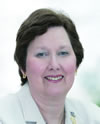
Carol Shukle of Our Lady of the Lake in Mound wondered why she was asked to serve on the Strategic Planning Task Force in 2009.
“I’m not a religious [sister], I don’t work for the archdiocese,” said Shukle, 58.
Yet, she had an important perspective to offer both as a parishioner and a past president (2007-2009) of the Archdiocesan Council of Catholic Women.
“I felt my role in the task force was to represent the rank and file parishioner,” she said. “I think the archdiocese has a lot of respect for the Council of Catholic Women. Plus, being the president, I was able to get around the archdiocese.”
Important role
As it turned out, Shukle and a few others on the task force played a big role in shaping the plan as it relates to lay pastoral leadership.
In a section of the plan devoted to lay leadership, the first item calls for lay pastoral leaders to complete six hours of ongoing formation sponsored by the archdiocese. This was a case of the task force making a recommendation, and Archbishop John Nienstedt adopting it.
“I was on the ministry subcommittee of the task force, and that was one of the things we talked a lot about,” Shukle said. “We felt it was very important for the leadership in every parish to have the highest level of ongoing formation possible. . . . . In order for a parish community to be vibrant, the people who are in leadership positions need to be well-educated and qualified.”
This point illustrates a reality about the plan that Shukle believes many can easily overlook — it’s more about making positive changes to improve the parishes and, ultimately, the archdiocese, than it is about merging and clustering individual parishes.
“This whole process has always had a vision beyond just plugging holes in the dike,” she said. “It’s a vision to help become the best archdiocese we can and the most vibrant archdiocesan church we can — that when all of this is done, we’ll be a better, stronger church.
“That’s why the role of the laity came to be discussed in this process. The role of lay staff is so integral to the way parishes function and meet the needs of the parishioners.”
Helping the laity
An important point in this plan, Shukle noted, is that the archdiocese is doing more than just telling lay pastoral leaders they need ongoing formation. It’s telling them that it will sponsor such formation. The plan calls for the archdiocese to organize at least two opportunities every year for ongoing formation for lay leaders.
On top of that, it is encouraging parishes to do the same, along with trying to channel leaders to enroll in the Archbishop Harry J. Flynn Catechetical Institute at the St. Paul Seminary School of Divinity, or enroll in graduate programs of theology or pastoral studies at the seminary. These programs will be offered at a discounted rate to men and women who work in parishes within the archdiocese.
“I’m pleased to see how they’ve taken this concept and outlined how they’re going to offer ongoing formation,” Shukle said. “It looks like the archdiocese is going to take a role in keeping their parish staffs up to date.”
Shukle hopes that when people review the strategic planning book they receive in parishes Oct. 16 to 17 that outlines the changes, they will note all of the positive changes and recognize the overall potential for improvement in the archdiocese.
“I’ve said all along to people I have talked to that there was just way too high a level of fear about this planning process,” she said. “Yes, there will be mergers, clusters and closings. It was inevitable that there would be some. But, not near the level that people feared. The whole point of the thing is to become a better, stronger church.
“I would say to the average parishioners: Give it a chance. Change can be painful, but try to see the big picture. . . . Cooperation among the parishes can make us better and stronger.”




